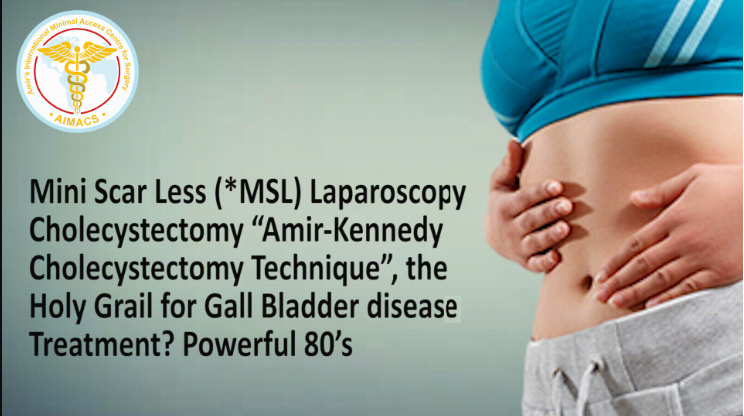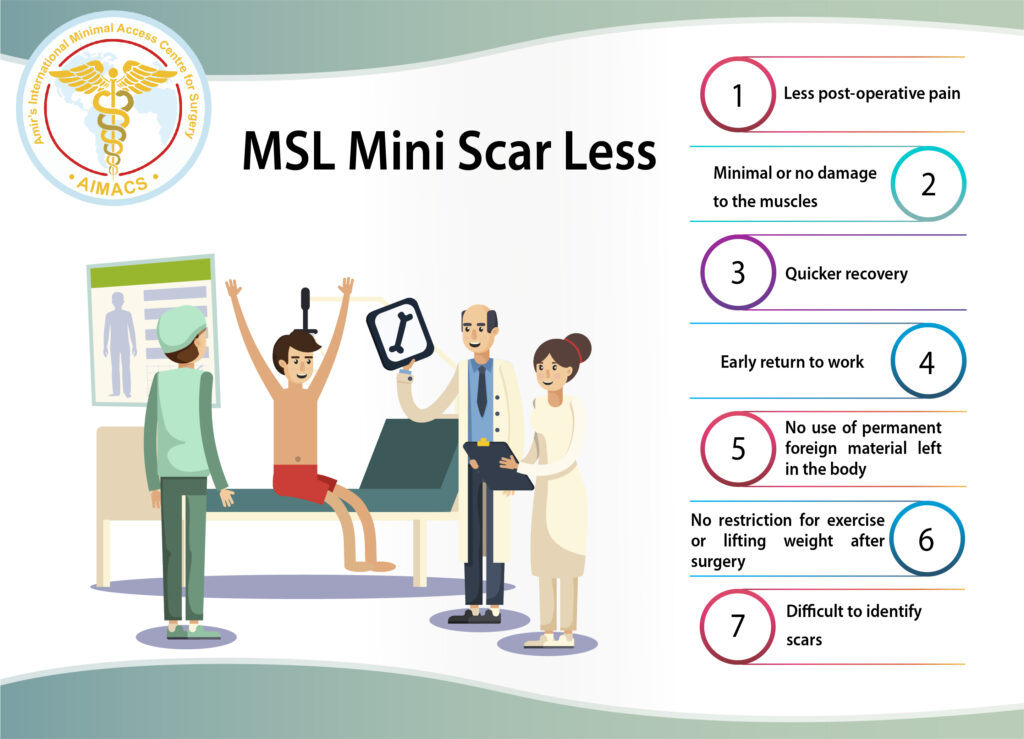Mini Scar Less (*MSL) Laparoscopic Cholecystectomy “Amir-Kennedy Cholecystectomy Technique”, the Holy Grail for Gall Bladder disease Treatment? Powerful 80’s

Author has 30 years’ experience of Laparoscopic surgery. He is a teacher and trainer in United Kingdom, Europe, Middle East and Asia in Gall Bladder disease surgery
From the first Gall Bladder removal operation nearly 135 years ago, nothing changed till 35 years back, when Laparoscopic Cholecystectomy (removal of Gall Bladder with camera and fine instruments) was introduced; which remained a standard operation till recent times. Now MSL LC (Mini Scar Less Laparoscopic Cholecystectomy) “Amir-Kennedy Cholecystectomy Technique” is presented as a potential new Gold Standard.

MSL LC (Mini Scar Less Laparoscopic Cholecystectomy), “Amir-Kennedy Cholecystectomy Technique” follows all the cardinal principals of good visualisation and triangulation of instruments with optimal azimuth angles for safe dissection and gall bladder retrieval. There are no short cuts or compromises in safety. The least possible cuts on the skin and muscle separation means that the accumulative length of the incisions (cuts) is so small that it offers the following over and above any other technique currently available for Gall bladder surgery:
- Less post-operative pain
- Minimal or no damage to the muscles
- Quicker recovery
- Early return to work
- No use of permanent foreign material left in the body, like metal clips
- No restriction for exercise or lifting weight after surgery
- Last but not the least, excellent cosmesis with scars so small (Mini Scar Less), that one may find it difficult to identify these, just a few weeks after the surgery – beach and catwalk worthy! Vanity matters!!

Author believes that this is the long-awaited progress in gall bladder surgery, that he has achieved in the form of MSL LC (Mini Scar Less Laparoscopic Cholecystectomy), “Amir-Kennedy Cholecystectomy Technique”.
Is this the Holy Grail in Gall Bladder surgery? May be for the next 5 years, until its improved further. The journey and quest continues.
The list of variations for various approaches for Gall bladder surgery are listed in terms of their preference in the opinion of author. The option on the top being most favourable and the rest in a descending order.
Safety, efficacy, muscle damage, permanent foreign body material used for surgery, post-operative pain, recovery, return to work, return to driving, return to exercise, cosmesis and cost effectiveness of surgery are the parameters considered.
- MSL LC (Minimal Scar Less Laparoscopic Cholecystectomy) – “Amir-Kennedy Cholecystectomy Technique”
- Needlescopic Cholecystectomy
- Standard Cholecystectomy
- Robotic Assisted Laparoscopic Cholecystectomy
- Single port Cholecystectomy
- e-NOTES (embryonic Natural Orifice Transluminal Endoscopic Surgery) Endoscopic & Laparoscopic assisted Cholecystectomy
- NOTES (Natural Orifice Transluminal Endoscopic Surgery) Endoscopic & Laparoscopic assisted Cholecystectomy
- Open Cholecystectomy
Comparison of Accumulative Incision Lengths
Open Cholecystectomy / SILS / e-NOTES / Robotic Assisted Laparoscopic Cholecystectomy / Laparoscopic Cholecystectomy / Needlescopic Cholecystectomy / Mini Scar Less (MSL) Laparoscopic Cholecystectomy, “Amir-Kennedy Technique”
Comparison Table
**Mini Scar Less (MSL) Laparoscopic Cholecystectomy “Amir-Kennedy Cholecystectomy Technique” | 1.4cm | 14mm | 0.55 inch |
| Needlescopic Cholecystectomy | 1.6cm | 16mm | 0.63 inch |
| Laparoscopic Cholecystectomy | 3cm | 30mm | 1.2 inches |
| Robotic Assisted Laparoscopic Cholecystectomy | 3cm | 30mm | 1.2 inches |
| SILS (Single Incision Laparoscopic Surgery) | 4.5cm | 45mm | 1.8 inches |
e-NOTES (embryonic Natural Orifice Transluminal Endoscopic Surgery) | 4.5cm | 45mm | 1.8 inches |
| ***Open Cholecystectomy | 20cm | 200mm | 8 inches |
*Mini Scar Less – No episode of skin breach is “Scarless”. Even a needle prick leaves a Scar on the skin. “Mini Scar Less” (MSL) means that the scar is so “Minimal” after surgery that it may appear “Scar Less” to the observers; mostly lay persons. This may not be the case in patients who have a tendency to get prominent/ Hypertrophic/ Keloid scars. This may also not be achievable if there was wound infection after the surgery. Caucasians are more likely to get finer and faint scars compared to Asians and Africans.
**Standard accumulative incision length in all comers
***Average accumulative incision length; may be longer in obese patients
